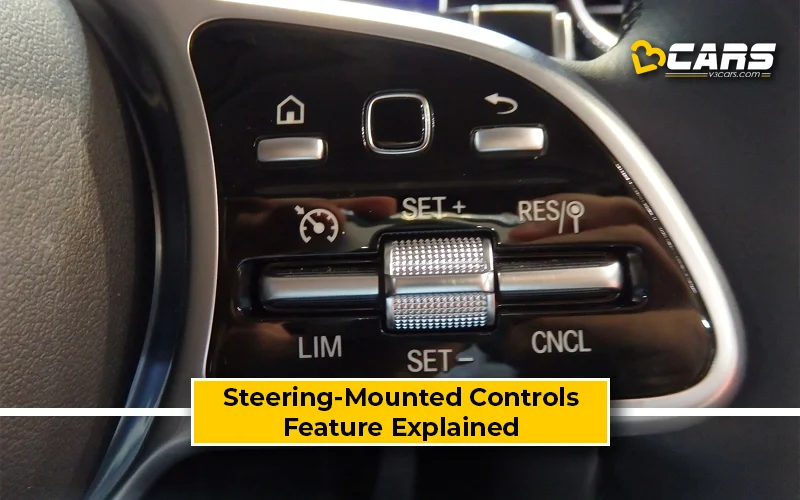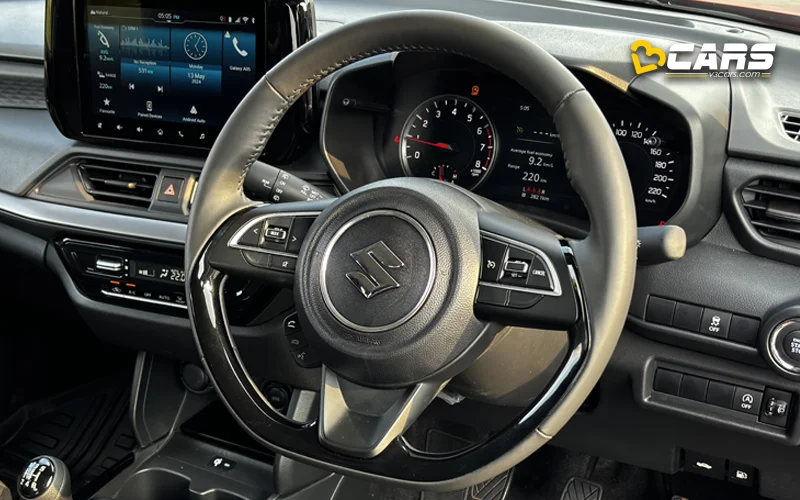What Is Steering-Mounted Controls? Feature Explained
In this Feature Explained article, we’ll present the most detailed analysis of steering-mounted controls or steering wheel controls. We’ll list out the pros and cons, explain how it works, provide the typical cost of getting steering mounted controls installed from the aftermarket, repair/replacement costs of this feature. Based on this analysis, we’ll suggest if you should have this feature in your next car or skip it.

What Are Steering-Mounted Controls?
Steering-mounted controls are buttons or joysticks, which are installed on the steering wheel spokes. Typically, cars have steering controls on the side spokes as most drivers hold the steering in the 9 and 3 o’clock position. It connects to the various features of the car like audio controls, cruise control, phone calls etc, allowing for easier and quicker access to important features in the car. Newer models are incorporating more and more features like ADAS and additional infotainment features.
Steering-mounted controls become all the more important from the road safety perspective if the car has touch-based or touchscreen-based controls for media playback. If the controls on the centre are not tactile and difficult to spot without taking your eyes off the road, then they pose a serious safety risk. Steering-mounted controls, in a way, also act as a safety feature and not just a convenience feature.
How Does Steering-Mounted Controls Work?
Steering wheel controls typically operate through a combination of physical buttons or switches and electronic communication with the vehicle's systems. Here’s a general overview of their functionality:
- Design: Steering wheel controls are integrated into the steering wheel itself, usually on the spokes or sometimes behind the wheel. Interior designers make and position them on the steering in such a way that they are easy to reach without even taking the hands off the steering wheel.
- Types Of Controls: Common controls include buttons for audio volume adjustment, changing radio stations, controlling phone calls (answer, hang up), activating voice commands, and managing cruise control functions.
- Mechanical Connection: These controls often use mechanical switches or buttons that physically activate or deactivate specific functions when pressed.
- Electronic Communication: Steering controls are connected to one of the car’s computers/ECU via wiring through the steering column.
What Are The Pros And Cons Of Steering-Mounted Controls?
The pros or advantages of steering-mounted controls are:
- Convenience: Controls on the steering wheel allow drivers to adjust the music volume, change track or radio station, select the source of music, and answer/end calls.
- Safety: Once the driver is familiar with the controls, they can manage them without even taking their eyes off the road. By reducing the need for drivers to look away from the road or reach for controls elsewhere in the vehicle, steering wheel controls help maintain focus and reduce distractions.
- Ergonomics: They contribute to better ergonomics by placing commonly used functions within easy reach, enhancing driver comfort during long journeys.
- Accessibility: They are particularly beneficial for drivers with disabilities or limited mobility, offering a more accessible way to manage vehicle functions. Vehicles that offer voice controls can also allow the driver to adjust air conditioning and open or close the sunroof if the car has these additional features.
The steering mounted controls has the following shortcomings or problems:
- Complexity: Steering wheel controls can sometimes be overwhelming or confusing, especially in vehicles with too many features. They can lead to potential distraction, especially for someone not familiar with the functions. For instance, driving a rental car or borrowing a car from someone with a bunch of steering controls can encourage the driver to explore them and fiddle with them while driving. Thus, they have some advantage from the safety POV but they also pose some safety risks.
- Cost: Vehicles equipped with advanced steering wheel controls may come at a higher cost due to the added technology and integration required. Since many manufacturers reserve these features for higher variants, you may have to spend a whole lot more if you consider this feature important to your ownership experience.
- Maintenance: Like any electronic component, steering wheel controls can malfunction over time, requiring maintenance or replacement. Therefore, you may have to spend a little more than expected during the ownership to maintain full functionality of this nifty little feature.
How Expensive Is It To Repair Or Replace Steering-Mounted Controls?
Typically, steering-mounted controls repair jobs can cost between Rs. 3,000 for a minor replacement to up to Rs.15,000 for a major job for a mass-market car. But it can also cost more if the point of failure is not just in the controls but the ECU.
Is It Possible To Install Aftermarket Steering-Mounted Controls And If So Then How Much Would It Cost?
Since all car makers offer steering-mounted controls in some or the other variant of all cars, it is possible to buy a steering-mounted control kit from the market. However, based on the popularity, it’s easier to find aftermarket solutions for cars, which sell in larger numbers.
Since the manufacturer will void your car’s warranty if you get an aftermarket steering-mounted control kit, we do not recommend getting this done post purchase. Especially, if your car is under warranty.
However, some models have the internal wiring already connected to the car’s computer/infotainment system. So, it’s totally possible to just get the necessary hardware and get it working without much snipping and splicing. Aftermarket steering controls for cars like the Grand Vitara, Creta etc. are available in the market for Rs. 3,000 - 5,000. It’s still extremely important to find an accessory shop, which has been selling and installing these for a while. The electrician should also have enough experience and knowledge of installing the kit on the same model car.
How Easy Or Complex Is It To Install Steering-Mounted controls?
For any car that has the steering-mounted controls in one of the higher variants, the process is fairly easy but not easy enough to DIY. If the higher variants get the feature, then the plugs and ports are often available in other variants, which makes it easy.
However, if you’re trying to install the steering-mounted controls in a car, which doesn’t get it at all in any of its variants, then it’s best to just skip it and find a way to live without these features. These days, even the most affordable cars like the Alto K10 and SPresso get the steering-mounted audio controls. So, you can very easily find spares to install steering controls on pretty much any car even after the purchase.
What Cars Get Steering-Mounted Controls?
Most base variants of cars that cost under Rs.10.0 lakh do not get this feature. It comes standard with most mid-spec models and almost all top end variants of cars with a starting price under Rs. 10.0 lakh. It is also common to see steering-mounted controls in all the variants of cars usually costing above 10.0 lakh.
Verdict — Should I Get Aftermarket Steering-Mounted Controls?
If your car didn’t come with steering-mounted controls from the factory, then you should consider exploring aftermarket options only if the higher variants of the car get this feature. Even then, you run the risk of losing warranty coverage because manufacturers are just looking for a reason to not give you warranty coverage when something goes wrong.
Post warranty, it’s okay to get this feature and while you’re at it, you may as well get the cruise control on the steering wheel to complete the style and feature set of the car’s steering.
Also Read: What Is Cruise Control? Working, Pros & Cons — Feature Explained
Note: Check your Car EMI with our - Car Loan EMI Calculator
You can use our Fuel Cost Calculator to see how any petrol, diesel or CNG car will cost to run based on the latest fuel price in your city.



0 Comments